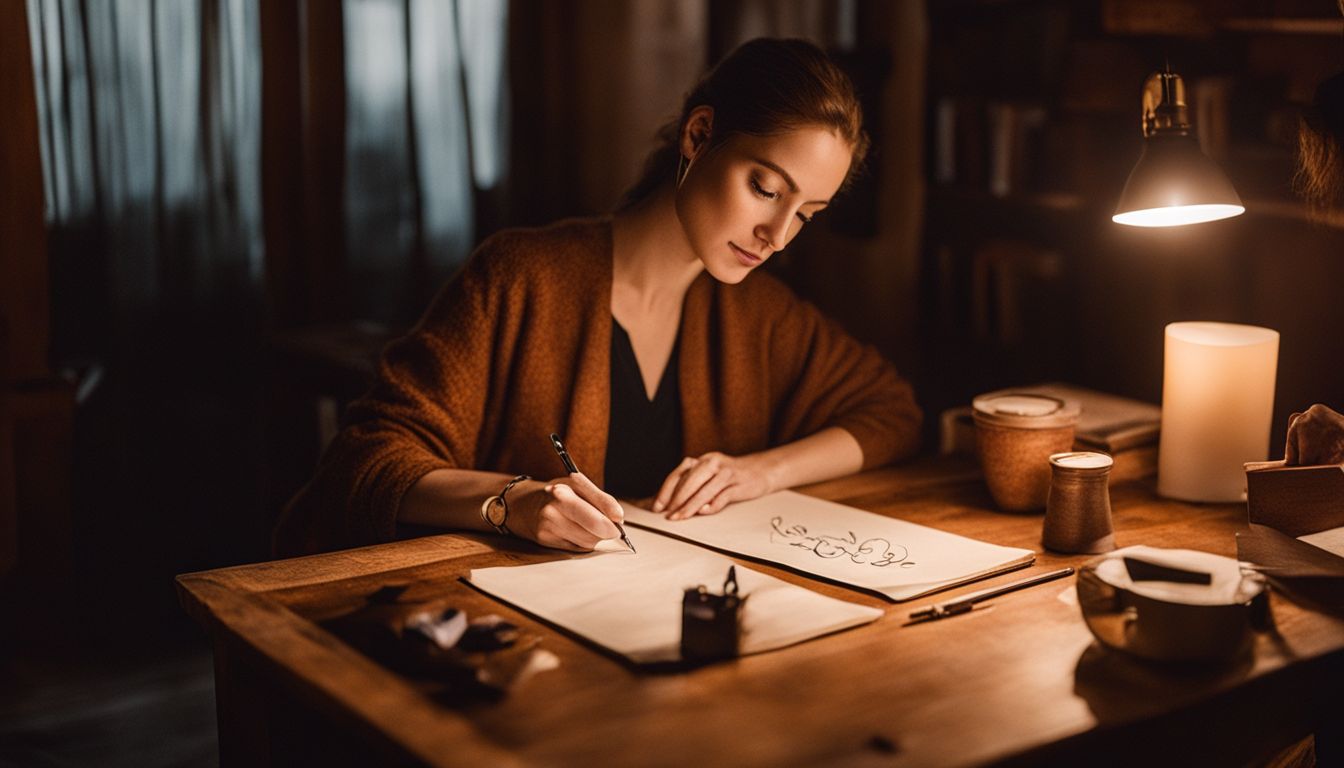Finding the right font is tough. Gothic calligraphy fonts have a rich history, starting in medieval times. This article shows how these fonts can improve your projects. Keep reading to uncover their secrets.
Key Characteristics of Gothic Calligraphy

Gothic calligraphy fonts are known for their bold, angular contours and dense, compact letterforms. These key characteristics give the text a strong and sturdy appearance, making it ideal for various design applications.
Bold, angular contours
Bold, angular contours are a signature trait of gothic fonts, making them stand out. These sharp edges and points add drama and intensity to the text. Artists use tools like flat-tipped pen nibs along with black ink, such as Speedball or Higgins, to create these distinct shapes.
With every stroke of the pen, they bring precision and depth to the letters.
Working with gothic script offers a hands-on experience in crafting detailed artwork. The equipment needed includes not just pens and ink but also pencils and erasers for sketching outlines before finalizing them in ink on practice sheets.
This process highlights the complexity behind those striking contours that define gothic calligraphy.
Dense and compact letterforms
Moving from the bold, angular contours of Gothic calligraphy, we turn our attention to its dense and compact letterforms. This quality makes Gothic calligraphy stand out. It packs letters closely together.
This packing gives designs a rich and full appearance that grabs your eye. Imagine writing that fills a page with thick blocks of text, creating an intense visual impact.
Gothic calligraphy’s tight spacing is perfect for making statements in design work. Designers can use alternate characters and ligatures to add uniqueness to each piece. These features allow for creative flexibility while maintaining the text’s overall density.
By practicing on cardstock or Bristol paper, one can master these dense letterforms through repetitive practice of downward serif strokes. This skill is essential for anyone looking to explore Fraktur, Old English, or any other style within this genre for their projects or webfont designs.
Popular Styles within Gothic Calligraphy
Gothic calligraphy encompasses various popular styles, each with its unique characteristics and historical significance. These styles include Fraktur, Old English, and Blackletter, which have influenced the development of typography and graphic design.
Fraktur
Fraktur stands out as a striking style within Gothic calligraphy, flourishing between the 16th and 18th centuries. Artists admired it for its intricate and ornate letter designs. People often use this font in historical documents and texts, capturing the elaborate aesthetic of its time.
Fraktur fonts incorporate dense and decorative elements, making them a favorite choice for those looking to add a touch of elegance and history to their projects.
Working with Fraktur font files offers a unique experience. It requires paying close attention to the details that make up each character’s elaborate forms. From personal projects like creating event invitations or designing logos, using Fraktur adds an antique yet sophisticated flair.
Its popularity among designers seeking to evoke a sense of tradition and craftsmanship in their work continues, proving that old styles can indeed find new life in modern design endeavors.
Old English
Old English, also known as Anglo-Saxon, is a prominent style within Gothic calligraphy fonts. It dates back to the Middle Ages and is characterized by its ornate, interwoven lettering.
Typically used in formal documents, Old English exudes historical charm and elegance. Its elaborate and intricate design makes it a popular choice for creating invitations for special events or adding a touch of sophistication to logo designs.
The traditional appeal of Old English lends itself well to various applications including wedding invitations, certificates, and official seals, which require an air of antiquity and grandeur.
Designers seeking to infuse their projects with a sense of heritage often turn to Old English for its timeless aesthetic.
Blackletter
Blackletter, also known as Gothic script, has a rich history dating back to the Gothic period. It is distinguished by its dark and dense angular lettering, showcasing bold and compact letterforms.
This style was popularized during the Middle Ages and Renaissance in manuscripts, books, and official documents. Blackletter embodies a distinctive aesthetic that has influenced modern typography and design, making it an essential component of historical-themed projects.
The intricate detailing of blackletter fonts lends itself well to a range of applications such as event invitations, logo design, and poster art. The intense appeal of this style adds a touch of sophistication to various design projects, making it highly sought after among designers seeking impactful visual elements for their creations.
When applied with attention to detail and precision in spacing characters properly according to its specific stroke order ensures stunning results in any graphic or typographic project.
Top Gothic Calligraphy Fonts for Designers
Top Gothic calligraphy fonts provide a range of styles for designers to utilize in their projects. Each font offers unique visual elements and historical influences, allowing designers to create captivating and impactful designs.
Cattedrale: A Classic Gothic Style
Cattedrale is a classic Gothic calligraphy font esteemed for its timeless appeal and intricate details. It features bold, angular contours and dense, compact letterforms that exude an air of medieval elegance.
This style offers multilingual support, with OTF and TTF formats available, as well as ornaments and symbols to enrich your designs. With its rich history and enduring charm, Cattedrale is a versatile choice for various design projects – from event invitations to logo design and poster art.
Cattedrale features four distinct styles that cater to different design needs, making it a customized option for designers seeking unique Gothic fonts. Whether you’re immersing yourself in the intricacies of event invitations or undertaking a personalized logo creation, Cattedrale’s ornate details are crafted to elevate your work across different creative expression realms.
Acude: Victorian Influences
Acude, a gothic calligraphy font, showcases intricate Victorian influences. Crafted with decorative blackletter style, it offers a plethora of glyphs and ligatures enhancing its ornate appeal.
This font is available in OTF and TTF formats to ensure accessibility for various design projects.
Rozex: Bold and Decorative
Rozex font is a bold and decorative choice for designers looking to infuse medieval aesthetics into their projects. This font showcases strong, angular contours that evoke a sense of grandeur and history.
Rozex offers both web and vector fonts in OTF and TTF formats, providing flexibility for various design applications. Designers can utilize Rozex to create striking event invitations, memorable logo designs, and captivating poster art.
Its bold and expressive letterforms make it an ideal choice for making a statement with typography in modern design projects.
The Rozex font stands out as a versatile option due to its ability to convey a sense of historical significance while remaining accessible for contemporary graphic design needs. With its distinctive medieval flair, this font brings an air of sophistication and strength to any visual communication or branding endeavor.
Cambridge: Strong and Sturdy
In regards to Gothic calligraphy, Cambridge is a font that stands out with its strong and sturdy presence. Its bold and angular contours give it an intense blackletter appeal, making it perfect for creating impactful designs.
With alternate characters included and web font options available in OTF and TTF formats, this typeface offers versatility for various design applications.
Designers looking for more than just a decorative touch can rely on Cambridge to enrich their work with its classic Gothic style designed to unveil the secrets of timeless typography.
Whether delving into logo design or poster art, this robust font is crafted to add a touch of old-world charm to modern creations.
Blackey: Intense Blackletter Appeal
Moving from the solid charm of Cambridge, let’s explore Blackey, a typeface that radiates a captivating blackletter charm. This timeless font effortlessly combines contemporary and classic elements, showcasing unique ligatures and strong multilingual support in both OTF and TTF formats.
Blackey is crafted for utmost impact with its bold style. It doesn’t just represent tradition but also caters to modern design requirements. Its careful craftsmanship supports the intricacies of the constantly changing realm of typography, positioning it as a preferred option for designers in search of a customized aesthetic.
Applications of Gothic Calligraphy Fonts
Gothic calligraphy fonts find applications in event invitations, logo design, and poster art. They offer a unique and striking visual appeal that can elevate the overall aesthetic of these design projects.
Event Invitations
Gothic calligraphy fonts are highly suitable for event invitations due to their elegant and formal aesthetic. These fonts add a sophisticated touch to wedding invitations, formal dinner invites, and other special occasions.
The bold, angular contours of Gothic calligraphy make it ideal for creating visually striking text that sets the tone for exclusive events.
When selecting a Gothic calligraphy font for event invitations, consider styles like Fraktur or Old English to infuse a sense of tradition and grandeur into the design. Incorporating these fonts can elevate the overall look of the invitation and leave a lasting impression on recipients.
To maximize the impact of Gothic calligraphy in event invitations, designers can play with kerning and spacing to ensure that the text flows seamlessly while maintaining its distinctive allure.
By mastering these techniques, designers can tailor custom event invitations that exude sophistication and charm.
Moving onto “Logo Design”…
Logo Design
Gothic calligraphy fonts offer a distinctive and historical appearance for logos. Designers commonly utilize these fonts in branding to evoke a vintage or medieval theme, adding an antique charm to their logo designs.
These fonts are particularly favored for businesses looking for a unique and timeless aesthetic.
When integrating Gothic calligraphy fonts into logo design, it’s crucial to consider the brand’s identity and the message it intends to convey. The bold, angular contours of these fonts can contribute to creating a strong visual impact, making them suitable for businesses aiming for a memorable and striking logo presence.
Moreover, while aligning with specific industries such as fashion, artisanal crafts, or historical sites, Gothic calligraphy fonts can effectively communicate the brand’s essence while maintaining readability and versatility across digital and print platforms.
To sum up, integrating Gothic calligraphy fonts into logo design is aimed at enhancing the overall branding experience by producing strong visual elements that capture the attention of target audiences.
Poster Art
Gothic calligraphy fonts are widely used in creating striking and bold poster designs. Their intense blackletter appeal and decorative qualities make them perfect for concert posters, horror movie promotions, and fantasy-themed events.
The bold, angular contours and dense letterforms of Gothic fonts can add a sense of drama and mystique to any poster design. With their strong presence and intricate details, these fonts effortlessly capture attention and emphasize the theme or message of the poster.
Tips for Mastering Gothic Calligraphy
Master Gothic calligraphy by practicing stroke order and perfecting kerning and spacing. Master this art form, impart your designs with the elegance of gothic fonts.
Understanding stroke order
Practice downward serif strokes for one or two lines to gain control and precision over the pen’s movement. Then, master upward serif strokes to reinforce consistent writing style.
Detailed stroke instructions are available for complex letters like “k.” Familiarize yourself with these directional guidelines to enhance your Gothic calligraphy skills.
Moving on to exploring popular styles within Gothic Calligraphy, let’s delve into the intricacies of Fraktur and Old English script variations.
Practicing kerning and spacing
To create cohesive and visually appealing designs using Gothic calligraphy fonts, it’s essential to practice letter spacing and kerning with great care. Adjusting the size, color, and spacing of letters is crucial for enhancing the visual appeal of any design.
By understanding stroke order and practicing the entire uppercase Gothic alphabet, designers can create elaborate and well-balanced compositions. Moreover, selecting the right Gothic font for different design contexts is essential for both legibility and aesthetic coherence.
For example, when designing event invitations or logo art, precise kerning ensures that each letter fits snugly next to its neighbor, maintaining a harmonious balance within the design.
Understanding how to adjust spacing between letters elevates a designer’s ability to create custom designs tailored for specific applications such as poster art or logo branding. This skill not only enhances the realm of typography but also enriches direct experience in navigating complexities within the ever-evolving world of design.
Hence, mastering kerning and spacing not only showcases an ability to delve into intricate details but also guarantees strong artistic expression through typefaces like Gothic calligraphy fonts.
Conclusion: Integrating Gothic Fonts in Modern Design
Exploring the realm of Gothic calligraphy fonts has unveiled countless creative opportunities for designers. Incorporating these ornate and intricate letterforms into modern design projects can add a touch of medieval elegance and sophistication.
From event invitations to logo design, the applications are diverse and tailored to various artistic styles.
Gothic calligraphy offers a unique avenue for designers seeking more than just standard typography. The bold and angular contours, combined with dense and compact letterforms, underpin a style that is not only visually captivating but also crafted to enhance visual storytelling.
When mastering these fonts, understanding stroke order is crucial while maintaining a balance between decorative elements and readability.
In the ever-evolving design landscape, delving into this journey through the intricacies of Gothic calligraphy opens up a first-hand experience in creating customized designs that stand out amongst others.
By following the tips outlined in this comprehensive guide and exploring online resources for inspiration, designers can confidently immerse themselves in integrating Gothic fonts with other styles to craft strong and distinctive visual identities.
If you’re intrigued by the history and application of calligraphy, you might also enjoy exploring the elegance of modern Arabic calligraphy.
FAQs
1. What is the beauty of Gothic Calligraphy Fonts?
Gothic Calligraphy Fonts are unique and artistic, their intricate designs showcase a blend of elegance and history that adds beauty to written works.
2. How can I explore Gothic Calligraphy Fonts?
You can explore Gothic Calligraphy Fonts by studying various examples, practicing writing in these styles, or using a comprehensive guide for reference.
3. Can anyone learn about Gothic Calligraphy Fonts?
Yes! Anyone with an interest in fonts or calligraphy can learn about the beautiful details and rich history of Gothic Calligraphy through study guides or practice books.
4. Why should I use a comprehensive guide for exploring Gothic Calligraphy Fonts?
A comprehensive guide provides detailed information on different types of gothic fonts, techniques for writing them, and their historical significance which enhances your understanding and appreciation for this art form.




Leave a Reply
You must be logged in to post a comment.